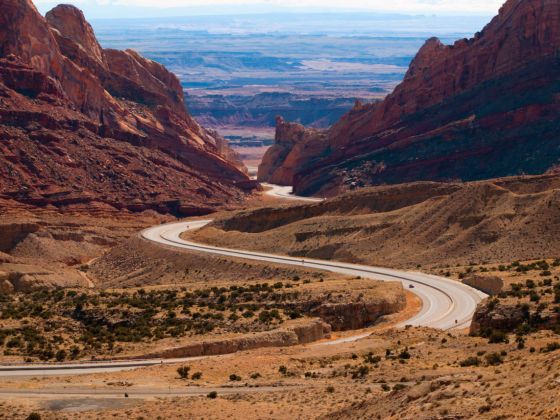MENTION ARIZONA and many people think of the Grand Canyon…maybe a few cacti and cow skulls tucked in the sand dunes come to mind, too. But the Grand Canyon is just the beginning, and actual sand dunes are rare here — the Sonoran Desert, which covers much of southwestern Arizona, is surprisingly lush.
In the sunniest corner of the country, nature and humanity have left their mark in unexpected ways. Visit Arizona and discover what geology, ambition, and technology have produced as you explore some of the state’s lesser-known landmarks — sites that wouldn’t be out of their league on a list with famous spots like Niagara Falls, Monticello, or Seattle’s Space Needle.
1. London Bridge, Lake Havasu City
London Bridge isn’t falling down — it’s framed by palm trees on a channel off the Colorado River.
Built in the 1830s, the bridge was never designed to withstand the heavy automobile traffic that was to descend on the British capital in later decades, and by the 20th century it was beginning to sink into the River Thames. So, in 1968, the City of London put it up for sale to the highest bidder. Sensing a brilliant opportunity to put his community on the map, Arizona entrepreneur Robert P. McCulloch paid nearly $2.5 million dollars for it. Of course, he then had to get the 932-foot-long bridge halfway across the world.
Each of the exterior stones was given a number, and the whole thing carefully disassembled and shipped to California, via the Panama Canal, before being trucked to Lake Havasu City. By 1971, the reconstruction work was finished — after another $7 million in expenses — and now you can kayak or jetski under these venerable but curiously located arches.
2. Meteor Crater, near Winslow
Formed by a nickel-iron meteor screaming towards Earth at around 26,000 miles per hour, this is one of the best preserved meteorite impact sites on the planet. Nearly a mile wide and over 500 feet deep, Meteor Crater was formed around 50,000 years ago, when the landscape was dominated by grasslands and grazed upon by woolly mammoths and giant ground sloths.
Scientists seeking to understand similar structures elsewhere in the solar system come here to study. Tours for the rest of us run every day, and you can find the crater about 18 miles west of Winslow. Space, well…it just rocks.
3. Cochise Head, Chiricahua National Monument
The profile of one of the most noted leaders of the Apache dominates the mountainous horizon within Chiricahua National Monument in the far southeast of the state. But unlike the Mount Rushmore or Crazy Horse Memorial landmarks in South Dakota, this likeness didn’t required artists or dynamite. Time and erosion have created the resemblance to the profile of Chief Cochise — just tilt your head to the right. There’s even a tall evergreen tree in the distance that stands in for the leader’s eyelashes. The best view is a short hike above the hoodoos, from the peak of Sugarloaf Mountain.
4. Taliesin West, Scottsdale
Come to this 500-acre preserve on the southern slopes of the McDowell Range to see “organic architecture” perfectly executed. Frank Lloyd Wright’s winter home and teaching space from the late 1930s onwards, the low buildings of Taliesin West use desert-scavenged, sun-bleached rocks (some with petroglyphs carved by indigenous peoples) and local wood to create a building that feels like a stunning extension of the desert.
As the headquarters of the Frank Lloyd Wright Foundation and a base for the Frank Lloyd Wright School of Architecture, many of the country’s most recognized designs began here. Join a docent-led tour and get a peek at the drafting room, where some of the most iconic buildings in the country were conjured up, including, yes, New York City’s Guggenheim Museum.
And if that’s not enough, there are a number of other Lloyd Wright designs to check out while you’re in Arizona, including Arizona State University’s concert hall in Tempe and the First Christian Church in Phoenix.
5. Arches, Northern Arizona
Arches aren’t just found in the red rock landscape of Utah’s national park — Northern Arizona shares the same geological idiosyncrasies. In fact, what was once thought to be one of the largest arches on the planet, Wrather Arch, is right here in the Grand Canyon State. Some people have said it’s tall enough that the Taj Mahal could fit under it, though that’s been disputed. Either way, yeah, it’s big.
It’s also fairly remote — an 18-mile hike in the Paria Canyon-Vermilion Cliffs Wilderness will get you to Wrather Arch. More easily accessible is Hope Arch, a graceful seven-story-tall opening in the sandstone just west of the town of Chinle. It’s in the Navajo Nation, so you’ll need to visit with a Navajo permit or guide.
6. Sunset Crater Volcano National Monument, near Flagstaff
In the 11th century, the ground here suddenly opened up and began spewing rock and lava. The local Sinagua people had to abandon their nearby villages and meadows as Sunset Crater, relatively young compared to its cousins stretched out in a string of volcanoes in this part of the country, did what volcanoes do best.
In the 20th century, NASA brought Apollo astronauts here to train for their lunar landings — you’ll see why on a visit. To protect the fragile land, you can no longer walk the trail leading to the moonlike crater, all brilliant reds and golds, but the trail at the base — studded with cinder deposits, lava flows, wildflowers, and pines — remains popular with hikers. For a deeper knowledge of the 3,040-acre national monument’s ecology and history, join a guided tour.
7. Davis-Monthan Air Force Base, Tucson
The world’s largest Airplane Boneyard is right here in Tucson. Low humidity, high altitude, plus naturally hard alkaline ground make Davis-Monthan Air Force Base the perfect “cemetery” for storing airplanes for spare parts. You may have seen this place in TV shows, music videos, or in a Transformers movie. Home to more than 4,400 planes, it’s a surreal visit. Sign up for a secured tour through the nearby Pima Air and Space Museum.
8. Sky Islands, Southeastern Arizona
Visitors to Southeastern Arizona are often struck by the vast mountain ranges rising suddenly out of the lowlands. Emerging from a “sea” of lower elevation desert, the mountain ranges here have been given the zen-like name of Sky Islands — cool, forested refuges for black bears, cougars, and humans just above the saguaros and prickly pears.
Topping out at 6,000 – 10,000 feet, where temperate and tropical zones meet, these ecosystems are some of the most diverse in the world and support more than half the bird species of North America. Look out for rare ones like the thick-billed parrot and buff-collared nightjar, as well as 18 species of hummingbirds.
One of only 11 national scenic trails in the U.S., the Arizona Trail runs from the Mexican border south of the Huachuca Mountains all the way north to the border with Utah along the Kaibab Plateau. Only hikers, horseback riders, and cyclists (and cross-country skiers in winter) are allowed on the trail, so it’s beautifully peaceful as you get to know the region’s varied landscape — and those Sky Islands — up close.
9. San Rafael Valley
Aside from some scenes shot in California studios, most of the classic musical Oklahoma! was filmed in the San Rafael Valley, in the border country near the city of Nogales. Bounded to the west by the Patagonia Mountains, to the north by the Canelo Hills, and to the east by the Huachuca Mountains, here you’ll find pronghorn antelope who share the rolling terrain with…vineyards?
Yes, Arizona’s faux-Oklahoma has become wine country, with an increasingly known terroir from the regions around Sonoita and Elgin. Sip, taste, and drink in the landscape.

